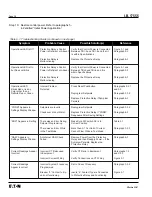
I.B. 17555
Page 23
Effective 03/97
a number of protective functions, such as inverse time
overcurrent and short delay protection are combined
into one cooperative curve. Figure 3-8 shows a typical
time-current curve which has both inverse time overcur-
rent and short delay protection, and an I
2
T curve shape
selected. Because of the pickup, time and curve shape
selections made for this illustration, a triangle (shaded
area on the illustration) is formed by the intersection of
the different time and pickup lines. Internally, the Digitrip
3000 design looks at this particular curve as if the shad-
ed triangular area does not exist. Therefore, in an actual
performance situation, the short delay time function
would take precedence over that portion of the inverse
time overcurrent line forming the one leg of the triangle.
This does not create a problem from a protection or
coordination standpoint. In fact, it is recommended on
certain applications to set the minimum time the Digitrip
3000 Protective Relay can respond and where it will
intersect the inverse time overcurrent curve. If only the
Short Delay Time is required, it is recommended that
the Short Delay setting be set at 11 times (I
n
). It could,
however, cause confusion if the combination of protec-
tion functions is not viewed as a coordinated activity.
For example, an individual might expect a tripping action
based on a selected low value for Inverse Time Over-
current Time Multiplier. The expected tripping action will
not take place at the expected time, if the Short Delay
Time selected is in the higher end of time selection pos-
sibilities. It should also be noted that this situation is
similar for other curve selections. The only thing that
changes with different curve selections is the general
shape of the triangle. When the Short Delay Time set-
ting is low enough, this situation will not exist. In sum-
mary, for a inverse time and short time cooperative
curve, the minimum trip time cannot be less than the
short delay time setting.
Instantaneous Protection
Instantaneous (short circuit) protection reacts to high
level fault currents. The instantaneous pickup setting
establishes the current level at which the relay’s instan-
taneous trip relay will be energized with no time delay
and is the instantaneous setting times (I
n
).
Table 2.2 specifies the possible settings, which are from
1 through 25 and “NONE.” If “NONE” is selected, the
instantaneous trip function is disabled and the discrimi-
nator option is offered. See paragraph 2-1.4 (Phase
Instantaneous) to review the discriminator option details.
If an Instantaneous Setting other than “NONE” is select-
ed, the instantaneous portion of the overall curve can be
TIME
CURRENT
Inverse Time Overcurrent
SD Time
Inst.
SD Pick-up
Inverse
Figure 3-8 Typical Curve with I
2
t Shape
TIME
CURRENT
Instantaneous pickup
is represented by the
dotted portion of the
curve.
Figure 3-9 Instantaneous Setting Adjustment















































